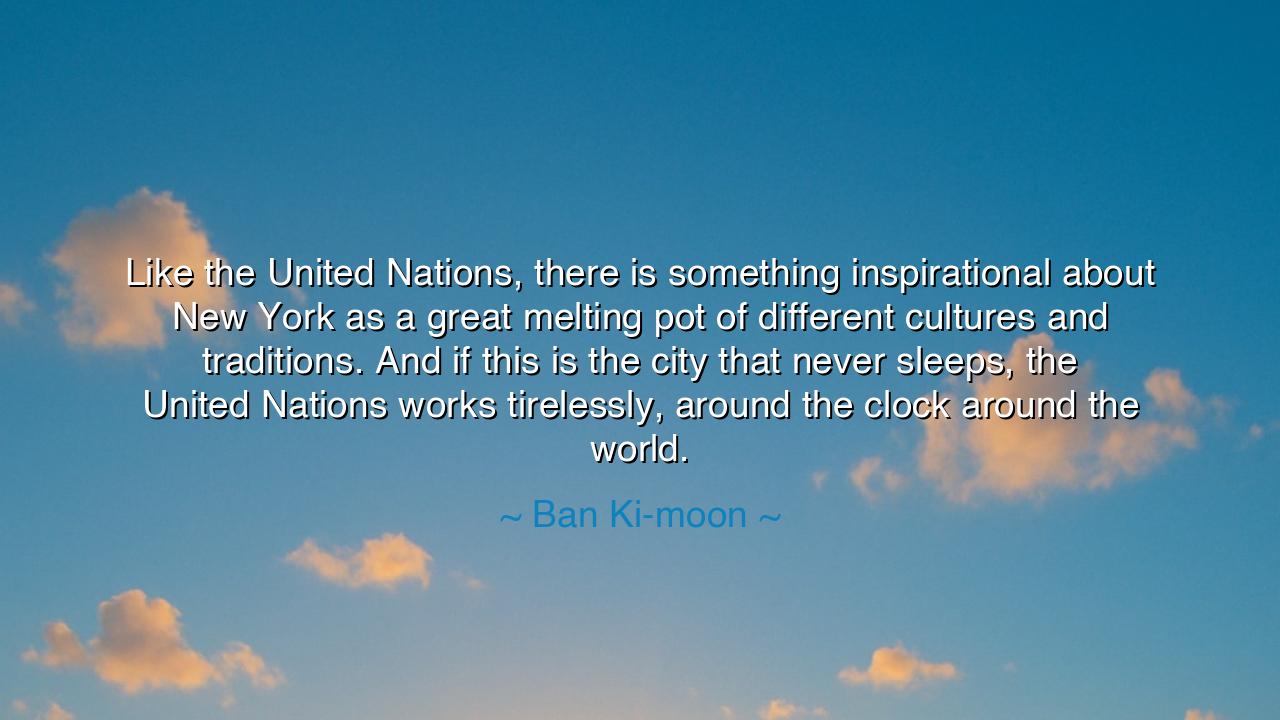
Like the United Nations, there is something inspirational about
Like the United Nations, there is something inspirational about New York as a great melting pot of different cultures and traditions. And if this is the city that never sleeps, the United Nations works tirelessly, around the clock around the world.






In the noble and poetic words of Ban Ki-moon, the former Secretary-General of the United Nations, there resounds a truth both ancient and enduring: “Like the United Nations, there is something inspirational about New York as a great melting pot of different cultures and traditions. And if this is the city that never sleeps, the United Nations works tirelessly, around the clock around the world.” These are not mere compliments to a city or an institution — they are words that honor the human spirit, the boundless energy of cooperation, and the tireless hope that peace may yet be forged from diversity. Ban Ki-moon speaks not as a politician, but as a servant of humanity, praising the shared vitality that binds the dreamers of New York with the diplomats of the world.
The meaning of his reflection lies in the parallel he draws between New York and the United Nations — two symbols of global unity. Both stand as meeting grounds for difference, places where languages, customs, and histories converge not to clash, but to create harmony. Just as the city’s streets pulse with countless accents and faces, so too does the UN’s chamber echo with the voices of nations — each distinct, yet striving toward common purpose. Ban Ki-moon sees in both the same sacred truth: that diversity is not division, but the raw material from which peace is crafted. He finds inspiration in the ceaseless movement of humanity — in the way cultures mix and merge like rivers joining in a single ocean.
The origin of this idea is older than either New York or the United Nations. It was born in the minds of sages who understood that unity is strongest when built upon difference. In ancient Athens, the philosopher Heraclitus taught that harmony is not the absence of tension but the joining of opposites — “the hidden harmony is better than the visible.” So too did Marcus Aurelius, emperor and philosopher, write that all men are bound by the same nature, “made for cooperation, like feet, like hands.” Ban Ki-moon, echoing these timeless truths, reminds us that the melting pot of cultures is not chaos, but creation — that out of many, one may emerge, not by erasure but by embrace.
New York, in his words, becomes more than a city; it becomes a living symbol of humanity’s potential. Within its skyline of ambition and its restless energy, one sees the embodiment of perseverance, resilience, and hope. Every immigrant who arrives carries a fragment of another world; every conversation on its streets is a meeting between histories. It is, as Ban suggests, the world in miniature — a place that never sleeps because its spirit never ceases. And so, when he likens the city to the United Nations, he honors both as sanctuaries of progress — one local, one global — both powered by the belief that humanity’s differences need not be its downfall, but its greatest strength.
Consider, for instance, the founding of the United Nations itself, born from the ashes of war. In 1945, representatives from fifty nations gathered in San Francisco, weary from conflict yet determined to build peace. Their work was not easy; mistrust ran deep, and the wounds of war were fresh. Yet, from their dialogue emerged the Charter of the United Nations, a testament to hope over despair. Like the builders of ancient temples, they laid the foundation for an edifice not of stone, but of spirit — one that, as Ban Ki-moon reminds us, continues to labor “around the clock around the world.” Theirs was the same tireless energy that moves New York — the conviction that humanity, though flawed, can aspire toward harmony through effort unending.
In his description of the UN’s tireless work, Ban invokes a tone almost sacred. For to serve peace is to take on an endless task, one that demands vigilance through the night and courage through the dawn. Just as the city that never sleeps hums with creativity and struggle, so does the United Nations carry the sleepless burden of diplomacy — mediating wars, feeding the hungry, sheltering the displaced, and protecting the earth itself. This ceaseless striving is what he calls inspirational, not because it is easy, but because it endures despite weariness. It is a work of faith — faith in dialogue, in cooperation, in the quiet heroism of human goodwill.
The lesson we draw from Ban Ki-moon’s words is profound: that the true greatness of humanity lies in connection, not isolation. Whether in the bustling streets of New York or in the halls of the United Nations, we are called to labor together — to listen, to compromise, to build. The inspirational power of diversity is not in the noise of difference, but in the symphony it can create when guided by purpose. And if both the city and the institution work tirelessly, then so too must each of us — in our own lives, in our own communities — become ambassadors of understanding, makers of peace.
Therefore, let his words remind us that the world is, in truth, one great city, vast and vibrant, filled with countless voices and visions. We are its citizens, its architects, its caretakers. Let us, like New York, never sleep in our striving toward compassion; and like the United Nations, let us work ceaselessly, not for power or pride, but for the enduring promise of unity through diversity. For in that labor — tireless, humble, and hopeful — lies the only inspiration that can truly change the world.






AAdministratorAdministrator
Welcome, honored guests. Please leave a comment, we will respond soon